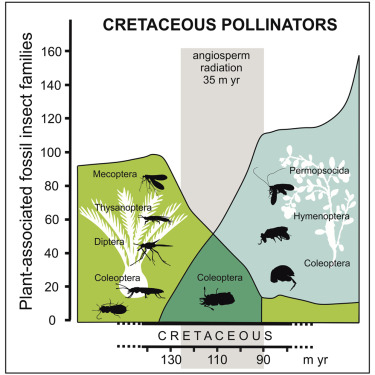iScience ( IF 5.8 ) Pub Date : 2020-03-18 , DOI: 10.1016/j.isci.2020.100913 David Peris 1 , Conrad C Labandeira 2 , Eduardo Barrón 3 , Xavier Delclòs 4 , Jes Rust 1 , Bo Wang 5

|
The Cretaceous fossil record of amber provides a variety of evidence that is essential for greater understanding of early pollination strategies. Here, we describe four pieces of ca. 99-million-year-old (early Cenomanian) Myanmar amber from Kachin containing four closely related genera of short-winged flower beetles (Coleoptera: Kateretidae) associated with abundant pollen grains identified as three distinct palynomorphotypes of the gymnosperm Cycadopites and Praenymphaeapollenites cenomaniensis gen. and sp. nov., a form-taxon of pollen from a basal angiosperm lineage of water lilies (Nymphaeales: Nymphaeaceae). We demonstrate how a gymnosperm to angiosperm plant-host shift occurred during the mid-Cretaceous, from a generalist pollen-feeding family of beetles, which served as a driving mechanism for the subsequent success of flowering plants.
中文翻译:

白垩纪中期的花粉甲虫专家。
琥珀的白垩纪化石记录提供了各种证据,对于更好地了解早期授粉策略至关重要。在这里,我们描述了大约四个部分。标识为裸子植物的三个不同palynomorphotypes丰富的花粉相关:99亿岁(早期森诺曼)缅甸克钦邦从含短翅花甲虫(鞘翅目Kateretidae)四个密切相关的属琥珀Cycadopites和Praenymphaeapollenites cenomaniensisgen。和sp。nov。,一种睡莲基部被子植物花粉的花粉形态类群(睡莲:睡莲科)。我们证明了在白垩纪中期,从多花粉甲虫的花粉喂养家族中,裸子植物向被子植物的寄主转移是如何发生的,这是随后开花植物成功的驱动机制。


























 京公网安备 11010802027423号
京公网安备 11010802027423号